Ketosis is a metabolic state where the liver breaks down fat to produce ketones. Ketones, on a ketogenic diet, are the primary fuel source for the body. If you’re new to the ketogenic diet and you still have questions, consider reading our Comprehensive Beginner’s Guide to Keto >
There are three main ways to measure the ketones in your body, all of which have their advantages and disadvantages. The most common ways to measure and to see if you are at an ideal ketosis level for weight loss are:
- Blood Ketone Meter or Ketone Strips. Very accurate but the strips are extremely expensive.
- Breath Ketone Meters. More accurate than the urine strips, but can sometimes vary in accuracy. Cheaper than blood strips in the long-run.
- Urine Stricks. This will answer the question “Am I in ketosis?” but will not provide an accurate measure of blood ketones.
Scroll down to read a more in-depth analysis of each, and what we recommend for you.
Why Testing Your Ketone levels is Important for Keto Success
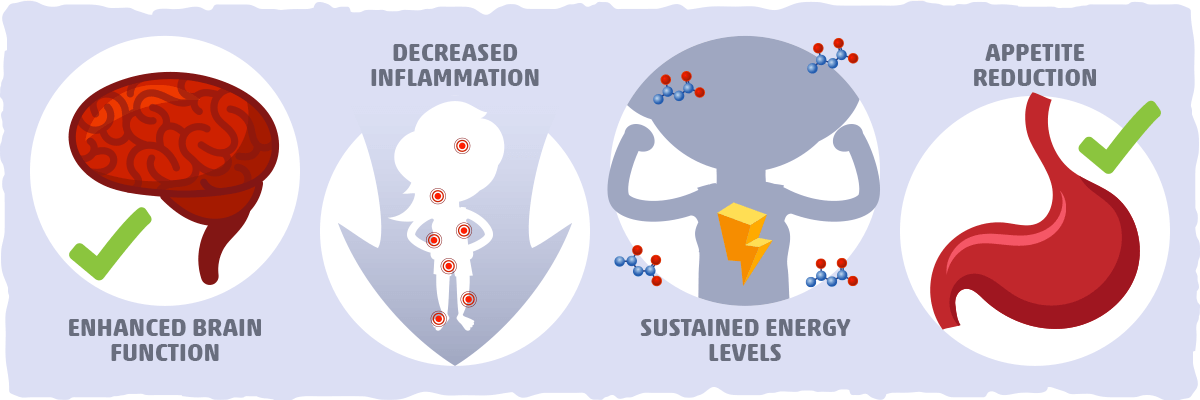
The keto diet is specifically formulated to help you achieve and sustain nutritional ketosis.
Those who are in this metabolic state tend to experience the following benefits:
- Enhanced brain function. For an extensive overview of the brain-based benefits of ketosis, check out our article on ketones and the brain.
- Decreased inflammation. Ketones are burned more efficiently than sugar, resulting in the production of less inflammatory compounds.
- Sustained energy levels. When we are in ketosis, we rely on more efficient energy sources (i.e., fat and ketones). This helps us maintain consistent energy levels throughout the day without having to struggle through sugar-driven energy crashes.
- Appetite reduction. Ketones can have an appetite-suppressing effect. This is why many keto dieters are able to lose significant amounts of fat without feeling starved or restricted.
In most cases, restricting carbs below 35 grams per day is all that is needed to enter ketosis and experience these benefits. However, this doesn’t always guarantee that your diet is ketogenic.
The most definitive way to determine if you are truly on a ketogenic diet — rather than a non-keto low-carb diet that doesn’t promote ketosis — is by measuring your ketone levels.
Measuring Ketones In Urine With Ketone Strips
Urine sticks will always be the cheapest and easiest way to measure ketosis. For beginners, this should cover everything you need – there is no point in getting more complex blood strips so early on when you are still trying to understand the nuances of a ketogenic diet.
Ultimately, keto sticks are very easy to use – you hold the sticks in your urine stream for a few seconds, and within 10-15 seconds you should notice a color change in the strip (if you are in ketosis). The color of the stick typically is measured in red: light pink being low in ketone production and dark purple being high in ketone production.
While keto sticks can be ideal for a general answer to the question “Am I in ketosis?”, they aren’t precise with their accuracy.
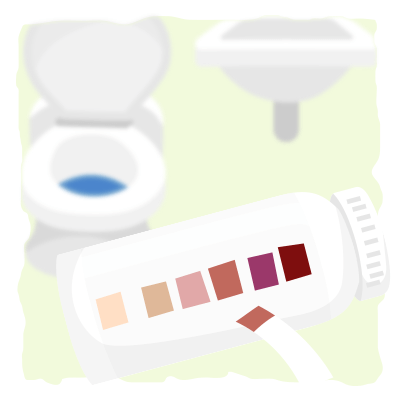
They measure the acetoacetate in your urine, which is an unused ketone by the body. As you get deeper into ketosis and your body adapts, your body will also become more optimized in ketone production.
You should notice a dark purple color when you’re newer to the ketogenic diet. If you’ve been on keto for many months, you’ll probably see a much lighter color. Many people assume this is a bad thing, but it’s usually not. Your body has just become more efficient at creating the ketones that fuel your body. If you’ve been following a ketogenic diet for a long time, it can be common for the sticks to give a false negative result.
The biggest advantage to measuring ketosis with urine sticks is that they are incredibly cheap and typically very easy to find. The best way to purchase them is to order them online (you can use coupon RULEDME to get 15% off).
The biggest disadvantage to these is their accuracy. Besides being inaccurate if you’ve been in ketosis for a long time, the sticks can also give varying results based on your hydration. If you’re properly hydrated, many times the sticks will read a much lighter color than if you were dehydrated.
When is the Best Time to Measure Ketones in Urine?
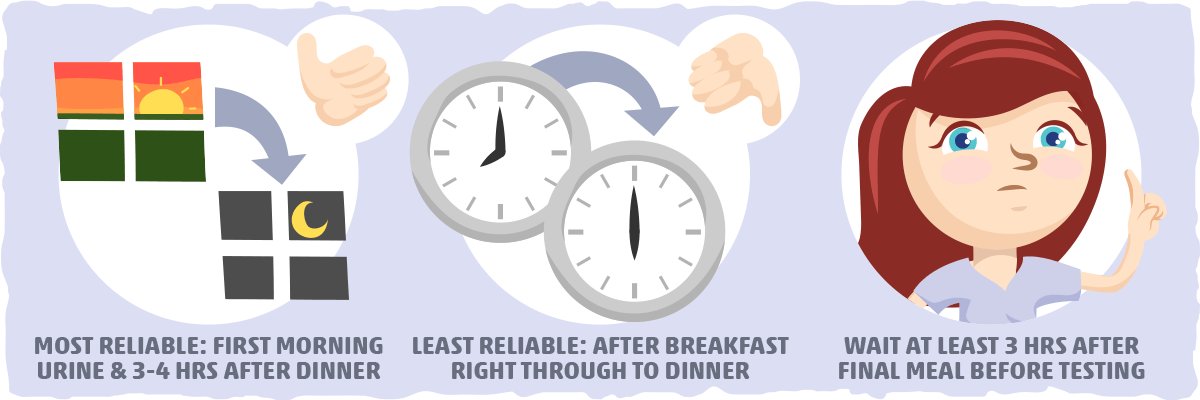
A quick search for the ideal ketone testing times will yield you dozens of hypotheses and plenty of confusion. Given the natural oscillations of ketone levels, hormones, and food intake throughout the day, when exactly should you test your urine to see if you’re in ketosis?
The best available data on this topic is from a 2016 study that was designed specifically to find the optimal time for urinary ketosis testing.
This study’s subjects were already in stable ketosis (confirmed via blood ketone testing after completing five weeks of the keto diet). They tested their urine for ketones 8x in one day and had their blood tested 18x for ketone levels throughout that same 24-hour period.
After analyzing the blood and urine ketone results, they found the most reliable urine tests were from the first morning urine and 3-4 hours after dinner.
In contrast, the least reliable timeframe was from shortly after breakfast through dinner. This is likely because their diet was formulated to maintain their weight and consisted of a keto meal or snack every 3 hours (starting with breakfast at 8 am).
Even if your diet looks significantly different from the subjects in this study, these results demonstrate a ketone testing principle that can be applied to any variation of keto eating: Wait at least 3 hours from your last morsel of food before testing.
Measuring Ketones with Breath Meters
Breath ketone meters are becoming more and more popular because of their simplicity. You connect it to your computer via USB and blow into it. From there, it measures the acetate in your breath – giving a good indication of your ketone levels.
They range from $150-200, so they are a pretty expensive upfront cost. We recommend that if you’re new to ketosis, you wait to buy one until you’re at a more advanced level. While breath meters are expensive upfront, it is much cheaper than the regular purchases of blood ketone strips. In the long-run, the most economical value for the results would be a breath analyzer – since you can reuse it as many times as you want.

Research shows that there is a pretty good correlation between acetate in the breath and the level of blood ketone meters, but can vary as you get deeper into ketosis. While they are much more accurate than the urine sticks, they can vary widely against the results of a blood ketone meter. This can sometimes lead to incorrect results, which may be misleading at times.
We recommend that if you’re on a budget, but you still want to have mostly accurate ketone readings, try Ketonix. If you can afford to purchase the blood strips and are adamant about the accuracy of each result, try a blood meter.
Note: Ketonix on Amazon is from a third-party seller that is currently gouging prices. Try to order directly from their website if you want to use a breath ketone meter.
Measuring Blood Ketone Levels
Blood ketone meters are the more accurate way to measure your level of ketosis. They show an exact and real-time measurement of the ketones in your blood, which is considered the “gold standard.” The biggest drawbacks of the blood strips are that they can get expensive quickly. They cost about $1 per strip, and most insurance providers don’t cover them.
Some slight drawbacks of blood ketone meters are their accuracy per device and their failed readings. Blood ketone readings will vary (though not greatly) between device and strips, even if they’re from the same brand. They can also occasionally fail readings, which means a wasted strip.
Remember as well that you do have to prick your fingers to draw a sample of blood for each reading. If you’re squeamish or don’t like to take blood, this may not be the best option.
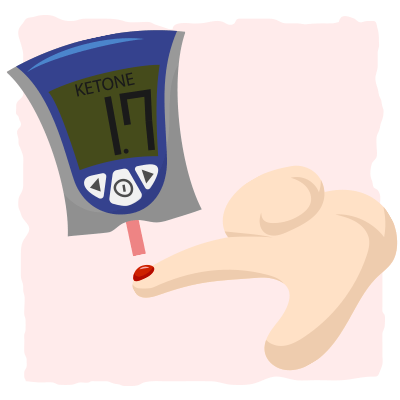
You can frequently find deals online for a free meter since they are cheap. The meter companies usually use a proprietary strip that only works on their machine – so they are more interested in you purchasing strips. If you’re not a deal hunter and want the most accurate way to measure ketone production, consider ordering the Precision Xtra (you will need extra strips).
How to Find the Best Blood Ketone Meter for Reliable Ketosis Testing
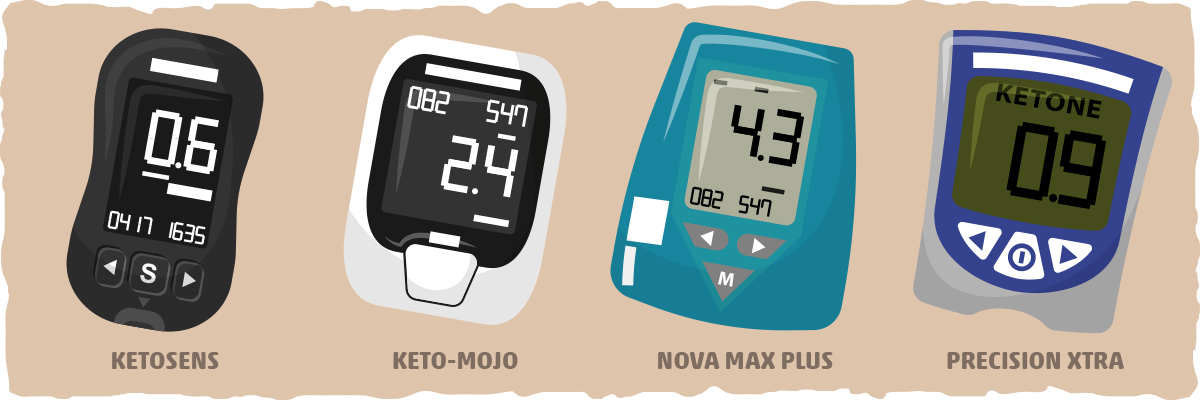
The four most recommended blood ketone monitors on the market are Keto-Mojo, Nova Max Plus, Precision Xtra, and KetoSens. Each one has been found to reliably determine when you are in deep ketosis, mild to moderate ketosis, or if you haven’t reached ketosis yet.
Ultimately, the blood ketone meter you end up choosing will most likely come down to the price of the test strips. As of February 2021, here are the prices for the four most popular blood ketone monitors (prices are from the US Amazon store):
| Meter price | Price/strip | 100 strips | Total cost | |
| KetoSens | $33.88 | $0.80 | $80 | $113.88 |
| Keto-Mojo | $44.99 | $ 0.99 | $99 | $143.99 |
| Nova Max Plus | $ 6.21 | $2.10 | $210 | $216.21 |
| Precision Xtra | $ 34.50 | $ 1.10 | $110 | $144.50 |
KetoSens is the most budget-friendly option, especially if you’re looking to test blood ketones regularly.
However, if you’re looking to track both blood sugar and ketone levels, KetoSens will not be the device for you. In this case, Keto-Mojo is the way to go.
Though Nova Max Plus and Precision Xtra can also track blood sugar, Keto-Mojo is the most cost-effective, and it comes with an app that helps track your results over time.
When is the Best Time to Test Blood Ketones?
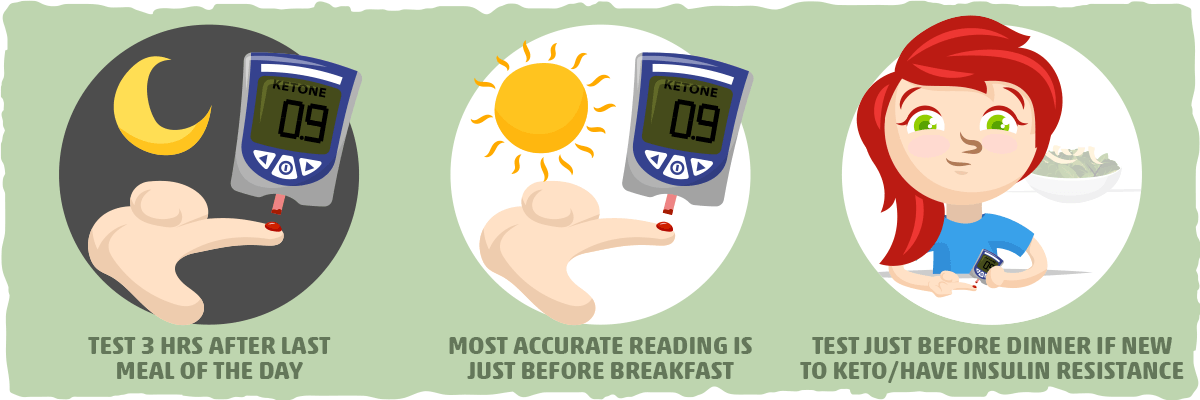
Following the same logic as urine ketosis testing, the best time to test ketones in the blood will be at least 3 hours after eating your last meal or snack.
Simply put, this means that we will get the most accurate reading before drinking coffee/tea or eating breakfast.
That said, if you recently started keto or you have insulin resistance, you will likely get the most reliable results after waiting 2-3 hours. This is due to what is known as the “dawning effect.” — when our blood sugar levels rise due to morning cortisol release.
Though this cortisol release is a natural phenomenon, it can have an initial negative impact on ketone production in first-time keto dieters and those with insulin resistance.
If waiting in the morning isn’t feasible for you, try measuring immediately before dinner (as long as you haven’t eaten lunch or a snack within the previous 3 hours).
Blood Ketone Level Chart: How to Know When You’re In Ketosis
Most people will be in light ketosis within two or three days after starting the ketogenic diet. It typically takes two to three weeks to start dipping into deep ketosis.
Here’s an overview of the numbers to help you figure out where you are on the ketosis spectrum:
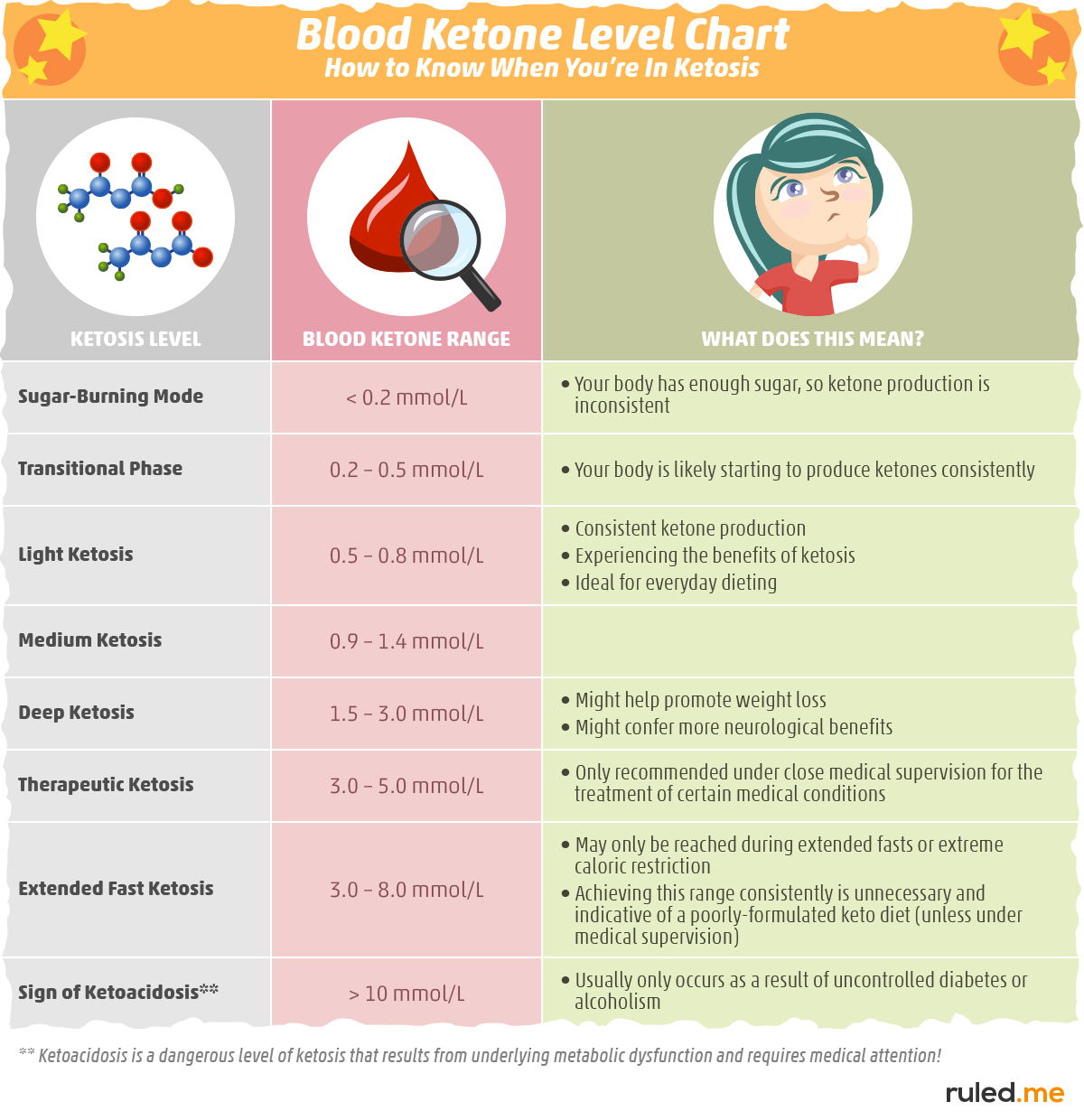
** Ketoacidosis is a dangerous level of ketosis that results from underlying metabolic dysfunction and requires medical attention. To learn more, read through our guide to ketoacidosis.
What is the Ideal Ketosis Level for Optimal Weight Loss?
Nutritional ketosis won’t promote weight loss directly, but it can decrease hunger, increase energy levels, and enhance mental clarity.
Altogether these unique benefits of ketosis can help us feel more satisfied and energized from fewer calories, resulting in more weight loss.
Though you can experience this from light ketosis, the current research suggests that the deep ketosis range will bring out these benefits to a greater degree. (Exactly how much greater is not yet known.)
The Bigger Picture: The Keto Diet, Ketone Levels, and Long-term Weight Loss Results
The hallmark of keto that sets it apart from any other diet is ketosis. However, this doesn’t mean that ketosis should be your primary focus.
What matters most is achieving your weight loss goals in a sustainable way for you, your health, and your lifestyle. Though ketosis can help you along the way, aiming to keep ketone levels as high as possible is unnecessary.
A more effective approach is to prioritize eating healthy keto-friendly foods in the right amounts for your goals. After a few days, ketosis will likely come along for the ride and provide you with an extra energy and satiety boost.

If you’d like to learn how to formulate a keto diet for your macro needs, weight loss goals, and food preferences, we’ve included several resources below:
- Keto Calculator — Calculate your daily macro goals for ketosis and weight loss.
- How to Start a Keto Diet — A three-step process for formulating your own keto diet.
- me Keto Meal Plan App — Skip the tedious task of planning and get a keto meal plan made for you.
Takeaways for Measuring Ketone Levels
Blood ketone readings will always be the most accurate way to track and monitor your level of ketosis. Here’s a quick guide on the ranges; optimal weight loss will be in the higher end of the “nutritional ketosis” and “deep ketosis” range:
- Light Ketosis: 0.2 mmol/L – 0.9 mmol/L
- Nutritional Ketosis: 0.9 mmol/L – 3.0 mmol/L
- Deep Ketosis: 3.1 mmol/L – 6.0 mmol/L
If you’re within deep ketosis ranges, you don’t have to strive for even higher readings. If you’re falling over the 3.0 mark, you won’t have any better or worse results than if you had a reading in the 2.5 range. Frequent high readings can sometimes show a lack of calories in your diet (ketosis also happens during starvation when the body needs to break down stored energy). Make sure to use our keto calculator to find your macros.
As a side note, it is important to talk about higher levels of ketones. Values over 10.0 mmol/L paired with blood sugar levels over 200 mg/dL can usually show the beginning of a dangerous state known as ketoacidosis. While it’s impossible to get to these ranges if your body is producing and recognizing insulin, diabetics can sometimes notice this when their insulin levels are low. Very high levels of ketones and blood sugar require medical attention and should be treated immediately. If you’re a diabetic, I recommend reading more about what ketoacidosis is.
Sources:
